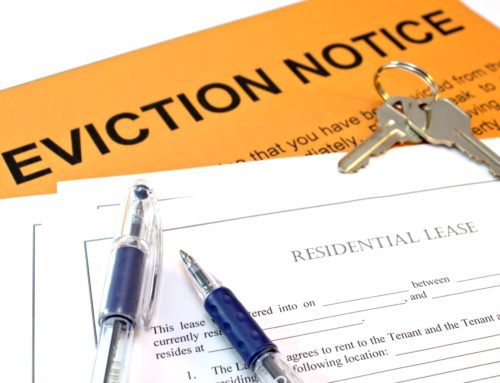As a landlord, you will inevitably have to deal with problematic tenants. In most cases, they are only minor inconveniences, but in some cases, they might be a nuisance and you’ll have to kick them out of your property as soon as possible.
Evicting a tenant out of your rental property is supported and regulated by the law. This means that a legal and formal eviction have a process that you must follow to make sure you are acting within local and state laws. The first step of the eviction process is giving the notice to vacate by writing a letter of eviction.
Evictions and Notices
There are two types of evictions: with cause, and without cause. Evictions with cause can usually fall under a material or financial violation. These include violations of the terms of the lease, property damage, reported illegal activity, and non-payment of rent
 If you have tenants that have made any of these violations, you may write to them a notice to vacate. Texas State law dictates the amount of time that must be given before the deadline to vacate, which depends on the case. If the tenants do not move out by the set date, you may proceed with filing an eviction suit.
If you have tenants that have made any of these violations, you may write to them a notice to vacate. Texas State law dictates the amount of time that must be given before the deadline to vacate, which depends on the case. If the tenants do not move out by the set date, you may proceed with filing an eviction suit.
Alternatively, you could also write to them a warning notice indicating what they are at fault for. For instance, you could write a notice to quit, a notice to pay the rent, or a notice of lease violation. In cases where the renter is allowed to correct his actions, the notice is called a curable notice, if not, it is called an incurable notice.
The other type of eviction, eviction without cause, typically applies to tenants whose lease has ended. You cannot evict a tenant protected under an active lease and must wait for his lease to expire unless he has committed a lease violation.
If you have questions about the legal process behind creating an eviction order and terminating a lease, don’t hesitate to contact a Frisco, TX landlord attorney at Girling Law. We are a TX, landlord law firm committed to protecting your personal property.
Contents of an Eviction Notice
When writing an eviction notice, you must be very careful to include all the necessary information because not including one could result in the tenant being able to have your notice scrapped, and you’ll have to write one again. This is the most common defense used by tenants fighting eviction.
Your eviction notice must contain addresses, dates, names of the tenant/s, date, and status of the lease, cause of the eviction (if applicable), deadline for vacating, and proof of notice delivery. Here are eviction notice form templates you can fill out:
Eviction Notice (Without Cause)
[Your Name]
[Address]
[City, State, Zip code]
[Email address and number]
[Date]
[Tenant Name]
[Address]
[Unit Number]
[City, State, Zip code]
Dear [Tenant Name]
YOU ARE HEREBY NOTIFIED THAT within [minimum number of days allowed by law] days from [date notice is given], you must vacate the property and relinquish possession of the premises at [property address] to [you or person in charge].
If you do not leave within [minimum number of days allowed by law] days, legal action may be taken against you to regain possession of the premises and seek remuneration for the damages caused by your illegal occupancy after this notice has expired.
This notice serves as a [minimum number of days allowed by law] days notice of the termination of your tenancy. Rent amounting to $[rent due] is hereby due on [date].
Sincerely,
[You or person in charge]
Evictions without cause generally apply to tenants that pay month-to-month and have not been a tenant for more than a year. The period you are allowed to give them to leave is equivalent to the frequency by which they pay rent. For instance, if a tenant pays rent monthly, you are to give them a month’s notice; if they pay every twenty days, you are to give them twenty-day notice.
Eviction with Cause
[Your Name]
[Address]
[City, State, Zip code]
[Email address and number]
[Date]
[Tenant Name]
[Address]
[Unit Number]
[City, State, Zip code]
Dear [Tenant Name]
Your [lease date] lease agreement clearly states that [lease agreement violated]. Because of your failure to comply with the rental agreement, the [name of premises] is given no choice but to serve this letter as a notice of eviction as of [date given].
You are hereby notified that within [minimum number of days allowed by law] days from [date notice is given], you must vacate the premises and relinquish possession of the promises at [property address] to [you or person in charge].
If you do not leave within [minimum number of days allowed by law] days, legal action may be taken against you to regain possession of the premises and seek remuneration for the damages caused by your illegal occupancy after this notice has expired.
Sincerely,
[You or person in charge]
According to Texas State law, for evictions with cause, a tenant must be given a three days notice period by which they must vacate. If they do not vacate, you may then sue them in court by filing an eviction lawsuit, also known as a forcible entry and detainer suit.
Remember that only an officer of the law is allowed to forcibly remove a tenant. If you try to remove a tenant yourself, you will violate tenant law and might be subject to a court order yourself in retaliation.
Evicting tenants is not easy because the process involves a lot of technicalities that must be followed or else your eviction case might just get dismissed. If you have problematic tenants, it is best to contact a Frisco, Texas landlord attorney for legal aid and to make sure your eviction case is airtight.





